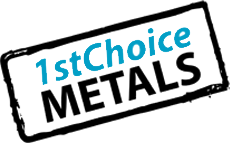What is an Aluminium Sheet?
Aluminium sheets are a widely used material across multiple industries, valued for their lightweight properties, durability, and adaptability. Whether you need to cut, bend, or join aluminium sheets, understanding the best techniques and tools is essential. This guide answers some of the most common questions about working with aluminium sheets.
What Makes Aluminium Sheets So Versatile?
An aluminium sheet is a flat-rolled metal product available in a range of thicknesses. It is commonly found in construction, automotive, aerospace, and DIY applications due to its resistance to corrosion and ease of manipulation. The versatility of aluminium makes it a reliable choice for both large-scale projects and home use.
How are Aluminium Sheets Cut?
When it comes to cutting aluminium sheets, selecting the right method depends on the sheet’s thickness and the desired level of precision. At 1st Choice Metals, we cut all our aluminium sheets using a guillotine, which ensures clean, straight cuts with minimal material waste. This is a highly efficient and widely used technique across the industry for sheet cutting. For customers who require additional precision, we also offer laser and waterjet cutting services, ideal for detailed or bespoke work.
For DIYers working at home, cutting thinner aluminium sheets can be achieved with basic tools such as tin snips, jigsaws, or circular saws fitted with a fine-toothed, carbide-tipped blade. If using these methods, it’s important to maintain steady control to ensure a smooth edge. For thinner sheets, tin snips provide a straightforward solution, while jigsaws or circular saws equipped with carbide-tipped blades offer more accuracy. Industrial settings often rely on laser or waterjet cutting for a flawless finish. Those attempting to cut aluminium sheets at home should ensure they use a fine-toothed blade and maintain steady control to achieve a smooth edge.
How are Aluminium Sheets Bent/Folded?
Aluminium’s malleability allows for various bending techniques. Hand bending works well for thinner sheets when using a straight edge and applying gradual pressure. A sheet metal brake is an effective tool for making precise folds, particularly in thicker materials. When handling 3mm aluminium sheet at home, careful scoring and clamping can make the process more manageable. In some cases, applying heat helps soften the metal, reducing the risk of cracks during the bending process.
How Do You Clean Aluminium Sheets?
Keeping aluminium sheets in top condition requires regular maintenance. A simple solution of mild soap and water is usually enough for routine cleaning, while tougher stains can be addressed with a mixture of vinegar and water. To restore shine and remove oxidation, specially formulated aluminium cleaners provide the best results. Harsh abrasives should be avoided, as they can damage the surface.
How Do You Join Aluminium Sheets?
There are multiple ways to join aluminium sheets together, each offering varying levels of strength and durability. Welding is a strong and permanent solution, commonly used in industrial settings. It requires skill and the right equipment due to aluminium’s high thermal conductivity and the formation of an oxide layer. For those looking for a simpler option, brazing is a quick and easy alternative. It uses a filler metal with a lower melting point than aluminium to create a smooth and strong bond. This method minimises distortion and works well with thinner sheets or more detailed work.
Another practical alternative is using our sheet joining strips, which provide a simple and effective way to connect aluminium sheets without the need for advanced tools or techniques. These strips are particularly useful when cladding walls, offering a strong and seamless connection suitable for both industrial and DIY projects.
Riveting remains a popular mechanical option, while welding requires specialised techniques due to aluminium’s heat conductivity. High-strength epoxy adhesives also provide a reliable alternative when welding is not practical.
How Do You Paint and Polish Aluminium Sheets?
For those looking to paint aluminium sheets, preparation is crucial. The surface must be cleaned thoroughly before applying an etch primer, ensuring that the paint adheres properly. Once primed, a high-quality metal paint will provide a durable finish. To achieve a polished look, sanding the sheet with fine-grit sandpaper, followed by a polishing compound and buffing wheel, will create a smooth and reflective surface. A protective wax or sealant helps maintain the polished appearance.
Can You Shape an Aluminium Sheet?
Aluminium’s flexibility allows it to be shaped using various tools. Hand tools are effective for light adjustments, while rollers and presses are commonly used in industrial applications. When working on intricate designs, heat forming can help achieve complex curves without compromising the material’s integrity.
Where Can You Buy An Aluminium Sheet?
For those seeking high-quality aluminium sheets, 1st Choice Metals offers a wide selection of sizes and thicknesses to meet different requirements. Whether for industrial use or home projects, we provide durable and reliable products. Visit our Aluminium Sheet & Plate section to explore our range.
Is an Aluminium Sheet Heat and Corrosion Resistant?
Aluminium exhibits excellent heat resistance, making it suitable for high-temperature applications. However, excessive heat exposure can cause warping, so precise control is necessary. One of aluminium’s greatest advantages is its natural resistance to corrosion. This is due to the oxide layer that forms on its surface, protecting it from rust and environmental damage, making it a great choice for outdoor and marine applications.
Can You Solder an Aluminium Sheet?
Soldering aluminium can be tricky due to its oxide layer, but with the right approach, it is achievable. Special aluminium soldering flux, along with low-temperature solder, is required to create a successful bond. Proper surface preparation is essential to remove oxidation before attempting to solder. In many cases, alternative methods such as welding or adhesives offer a more effective solution for joining aluminium sheets.
For premium aluminium sheets and expert guidance, visit 1st Choice Metals to explore our extensive range of high-quality metal products.
